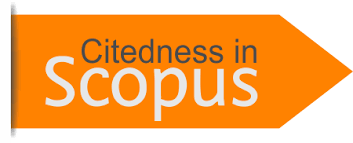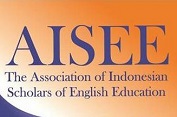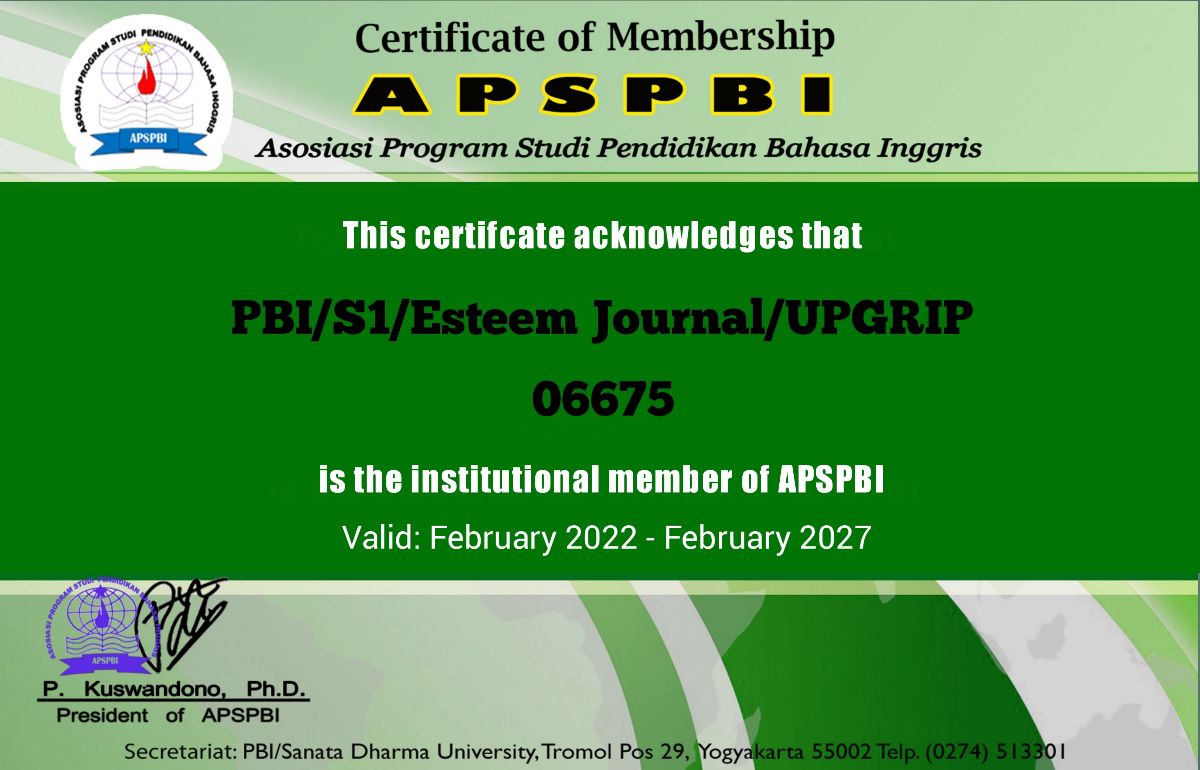The Effect of Crawford Series Teaching (CST) on the Students’ Writing Achievement
DOI:
https://doi.org/10.31851/esteem.v1i1.4827Keywords:
CST, writing, descriptive paragraphs.Abstract
Abstract: This experimental study aimed to investigate if there was any significant difference in writing ability between the students who were taught by Crawford series Teaching technique and those who were taught by using individual writing technique. Two classes of the first grade students of SMAN 5 Palembang were selected randomly as the sample of the study; experimental and control groups. Each group consisted of 28 students. The instrument used in this study was a set of pre and post-tests. This study used t-test to see the difference achievement between experimental and control groups in terms of writing descriptive paragraph. The result showed that the students in EG achieved better performance in writing descriptive paragraph. P-value got from T-test was 0.02; it was less than the level of significance (0.05). Furthermore, the mean score of the post-test of the EG increased 13.35 points compared to the pre-test, while there was a progress of 6.67 points in the CG. The result also showed a great improvement in the five aspects of writing (content and mechanical, organization, vocabulary, and grammar. In conclusion, students’ achievement in writing descriptive paragraph improved significantly through Crawford Series Teaching technique.
References
Crawford, A., Saul E.W., Mathews, S., & Makinster, J. (2005). Teaching and learning Crawford strategies for the thinking classroom. New York: The International Debate Education Association.
English First English Proficiency Index. (2014). EF EPI country rankings. Retrieved November 10, 2015 from http://www.ef.edu/epi.
Harmer, J. (1991). The practice of English language teaching. New York: Longman.
Harmer, J. (1998). How to teach English. New York: Longman.
Huda, N. (1999). Language learning and teaching: Issues and trends. Malang: IKIP Malang.
Johnson, D. W., Johnson, R. T., & Smith, K. A. (1998). Cooperative learning returns to collage:What evidence is there that it works? Edina, MN: Interaction Book Company.
Johnson, D. W. & Johnson, R. T. (2009). Making cooperative learning work. Edina, MN: Interaction Book Company.
Kagan, S. (1992). Cooperative learning. San Clemente, CA: Kagan Cooperative Learning.
Kagan, S. & Kagan, M. (2009). Kagan cooperative learning. San Clemente, CA: Kagan Publishing.
Lie, A. (2002). Cooperative learning: Mempraktikkan cooperative learning di ruang-ruang kelas. Jakarta: Grasindo.
Lightbown, P. M., & Spada, N. (2001). How languages are learned. Oxford: Oxford University Press.
McCafferty, S. G., Jacobs, G. M., & Iddings, A. C. D. (2006). Cooperative learning and second language teaching. Cambridge: Cambridge University Press.
Oshima, A. & Hogue, A. (1997). Introduction to academic writing. New York: Addison Wesley Publishing Company.
Reid, J. M., (2006). Essentials of teaching academic writing. Boston: Heinle.
Saharuddin. (2013). Perubahan kurikulum dan kualitas pendidikan di Indonesia. Retrieved November 10, 2015 from
http://www.kompasiana.com/%20saharuddin_lasari/perubahan-kurikulum-dan-kualitas-pendidikan-di-indonesia.
Santoso, R. (2011). Types of cooperative learning model CST Retrieved January 29, 2015 from http://serc.carleton.edu/introgeo/cooperative/techniques.html.
Sulisworo, D. & Suryani, F. (2014). The effect of cooperative learning, motivation and information technology literacy to achievement. International Journal of Learning & Development, 4(2), 58-64.
Swan, M. (2005). Practical English usage. Oxford: Oxford University Press.
Thornburry, S. (2002). How to teach vocabulary. London: England Pearson Education Limited.
Downloads
Published
Issue
Section
License
Copyright Notice
Authors who publish with this journal agree to the following terms:
In order to assure the highest standards for published articles, a peer review policy is applied. In pursue of the compliance with academic standards, all parties involved in the publishing process (the authors, the editors and the editorial board and the reviewers) agree to meet the responsibilities stated below in accordance to the Journal publication ethics and malpractice statement.
Duties of Authors:
- The author(s) warrant that the submitted article is an original work, which has not been previously published, and that they have obtained an agreement from any co-author(s) prior to the manuscript’s submission;
- The author(s) should not submit articles describing essentially the same research to more than one journal;
- The authors(s) make certain that the manuscript meets the terms of the Manuscript Submission Guideline regarding appropriate academic citation and that no copyright infringement occurs;
- The authors(s) should inform the editors about any conflict of interests and report any errors they subsequently, discover in their manuscript.
Duties of Editors and the Editorial Board:
- The editors, together with the editorial board, are responsible for deciding upon the publication or rejection of the submitted manuscripts based only on their originality, significance, and relevance to the domains of the journal;
- The editors evaluate the manuscripts compliance with academic criteria, the domains of the journal and the guidelines;
- The editors must at all times respect the confidentiality of any information pertaining to the submitted manuscripts;
- The editors assign the review of each manuscript to two reviewers chosen according to their domains of expertise. The editors must take into account any conflict of interest reported by the authors and the reviewers.
- The editors must ensure that the comments and recommendations of the reviewers are sent to the author(s) in due time and that the manuscripts are returned to the editors, who take the final decision to publish them or not.
Authors are permitted and encouraged to post online a pre-publication manuscript (but not the Publisher final formatted PDF version of the Work) in institutional repositories or on their Websites prior to and during the submission process, as it can lead to productive exchanges, as well as earlier and greater citation of published work (see The Effect of Open Access). Any such posting made before acceptance and publication of the Work shall be updated upon publication to include a reference to the Publisher-assigned DOI (Digital Object Identifier) and a link to the online abstract for the final published Work in the Journal.





























